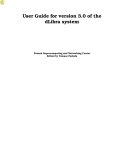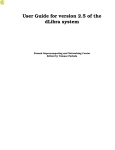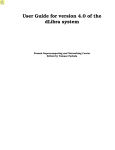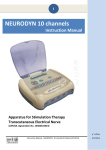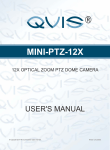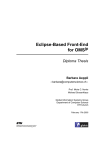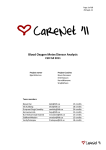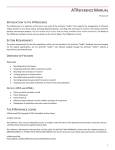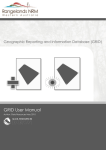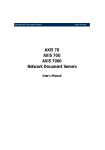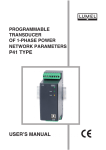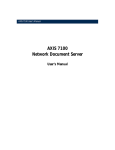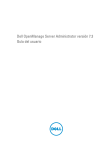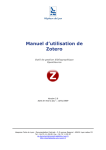Download dLibra User Guide
Transcript
dLibra User Guide Poznań Supercomputing and Networking Center Edited by Tomasz Parkoła dLibra User Guide by Tomasz Parkoła Copyright © 2002 - 2004 Poznań Supercomputing and Networking Center 2 Table of Contents 1. Basic concepts ....................................................................................................... 1 1.1. What is the dLibra for? ................................................................................ 1 1.2. Library structure ......................................................................................... 1 1.3. Library collections ...................................................................................... 1 1.4. Publication structure ................................................................................... 2 1.4.1. File versioning ................................................................................. 2 1.4.2. Publication editions .......................................................................... 2 1.5. Object attributes ......................................................................................... 3 1.6. Other library resources ................................................................................ 3 2. Program installation and startup ............................................................................ 4 2.1. GUI applications installation ....................................................................... 4 2.2. Starting dLibra GUI applications ................................................................. 4 2.2.1. Logging in to the dLibra system ........................................................ 5 3. Editor's Application .............................................................................................. 6 3.1. Editor's Application main window .............................................................. 6 3.1.1. Directories Tree ................................................................................ 7 3.1.2. Collections Tree ............................................................................... 7 3.1.3. Property editors ............................................................................... 8 3.1.4. Bibliographic description editor ........................................................ 9 3.1.5. Collections membership editor ........................................................ 15 3.1.6. Rights Editor .................................................................................. 18 3.1.7. Publication position editor .............................................................. 19 3.2. Publication Creator ................................................................................... 20 3.2.1. Publication Creator's functions ........................................................ 20 iii 3.2.2. Using Publication Creator ............................................................... 20 3.3. Mass publication upload ........................................................................... 24 3.3.1. Mass publication upload creator ...................................................... 24 3.3.2. Structure of a directory describing a publication ............................... 26 3.4. Common editor's tasks .............................................................................. 28 3.4.1. Creating a new publication ............................................................. 28 3.4.2. Creating a new planned publication ................................................ 32 3.4.3. Adding files to planned publication ................................................. 32 3.4.4. Creating a new group publication .................................................... 33 3.4.5. Downloading an edition of a publication .......................................... 33 3.4.6. Updating publication files ............................................................... 35 3.4.7. Creating an edition of a publication ................................................. 37 3.4.8. Publishing a publication edition ...................................................... 39 3.4.9. Assigning publication to collections ................................................. 39 3.4.10. Light deleting publication ............................................................. 40 4. Library Manager ................................................................................................. 41 4.1. Administrator's Application main window ................................................. 41 4.1.1. Library Tree ................................................................................... 42 4.2. Common administrator's tasks ................................................................... 43 4.2.1. Library directories management ...................................................... 43 4.2.2. Library collections management ...................................................... 44 4.2.3. Library attributes management ........................................................ 45 4.2.4. Attributes' values dictionary management ....................................... 48 4.2.5. Users and groups management ....................................................... 53 4.3. Advanced right management ..................................................................... 58 4.3.1. Introduction ................................................................................... 58 4.3.2. Library-level permissions ................................................................ 59 4.3.3. Directory-level permissions ............................................................. 59 4.3.4. Collection-level permissions ............................................................ 61 4.3.5. Publication-level permissions .......................................................... 62 4.4. Access domains management .................................................................... 63 A. MARC Import .................................................................................................... 65 A.1. Configuration file format .......................................................................... 65 B. Attributes' values' Synonyms Dictionary ............................................................... 67 B.1. The idea of Synonyms Dictionary .............................................................. 67 B.2. Construction of Synonyms Dictionary ........................................................ 67 iv List of Figures 1.1. File versioning and publication editions ............................................................... 3 2.1. dLibra startup application ................................................................................... 4 2.2. Login Dialog ...................................................................................................... 5 2.3. Login Profiles Editor ........................................................................................... 5 3.1. Editor's Application main window ...................................................................... 6 3.2. Attribute Editor ................................................................................................ 10 3.3. Selecting group for a value ................................................................................ 11 3.4. Choosing attribute's values ................................................................................ 11 3.5. Element's bibliographic description .................................................................... 13 3.6. MARC attributes import settings ........................................................................ 14 3.7. MARC attributes import .................................................................................... 14 3.8. Okno wyboru rekordu MARC. ........................................................................... 14 3.9. Adding publication into collections .................................................................... 16 3.10. Collection's publications management .............................................................. 17 3.11. Right Editor - publication rights ....................................................................... 18 3.12. Publication position editor - publication positioning .......................................... 19 3.13. Publication Creator - Information about files tab ................................................ 21 3.14. Publication Creator - Information about publication tab ..................................... 22 3.15. Publication Creator - Information about templates tab ....................................... 23 3.16. Mass publication upload creator - publications selection. ................................... 24 3.17. Mass publication upload creator - publications upload. ...................................... 25 3.18. New Publication Wizard - attribute values page ................................................ 29 3.19. New Publication Wizard - publication rights page ............................................. 29 3.20. New Publication Wizard - publication's collections page .................................... 30 v 3.21. New Publication Wizard - publication properties page ...................................... 30 3.22. New Publication Wizard - main publication file page ........................................ 31 3.23. New Publication Wizard - publication files upload page .................................... 32 3.24. Download Wizard - publication file selection page ............................................ 34 3.25. Download wizard - file download page ............................................................ 35 3.26. File Update Wizard - updated files directory page ............................................. 36 3.27. File Update Wizard - file upload page ............................................................... 37 3.28. New Edition Wizard - file versions selection page ............................................. 38 3.29. New Edition Wizard - edition properties page ................................................... 39 4.1. Administrator's Application main window ......................................................... 41 4.2. New Directory Wizard ...................................................................................... 43 4.3. New Collection Wizard ..................................................................................... 44 4.4. Attributes management ..................................................................................... 45 4.5. Attributes properties ......................................................................................... 46 4.6. New Attribute Wizard ....................................................................................... 47 4.7. Attributes values management ........................................................................... 49 4.8. Choosing a group to merge ................................................................................ 50 4.9. Editing an attribute's value's name ..................................................................... 51 4.10. Attribute's name edition dialog ........................................................................ 52 4.11. List of editions and directories connected with a value ....................................... 53 4.12. New User Dialog ............................................................................................. 54 4.13. User Groups tab .............................................................................................. 54 4.14. New Group Dialog .......................................................................................... 55 4.15. Group Members tab ........................................................................................ 56 4.16. New LDAP Group Dialog ................................................................................ 57 4.17. Group definition tab ....................................................................................... 58 4.18. User administrative rights tab .......................................................................... 59 4.19. Directory-level rights editor ............................................................................. 61 4.20. Collection-level rights editor ............................................................................ 62 4.21. Publication-level rights editor .......................................................................... 63 4.22. User access domains ........................................................................................ 64 A.1. A content of default MARC import configuration file ......................................... 65 vi 1 Basic concepts This chapter introduces basic concepts of the dLibra Digital Library Framework. 1.1 What is the dLibra for? The dLibra Digital Library Framework is a set of tools that support setting up, accessing and maintaining a library of digital documents of various types (e.g. scientific articles, reports, manuals, HTML pages). GUI applications provide an intuitive interface for manipulating library contents, whereas a web-based application supports browsing, searching and viewing stored documents. 1.2 Library structure All the documents stored in the dLibra library are organized in a hierarchical structure of directories. Every directory can contain any number of documents or subdirectories. Directories provide a structural order in a library. In most cases documents will be assigned to directories accordingly to their owner or e.g. to the company department they belong to. However, as some users of the library may not have access to every dLibra directory, particular user's view of the library tree may vary depending on their rights to the library objects. 1.3 Library collections Directories are only meant to order the set of library publication. Logical structure is kept by the mechanism of library collections. In dLibra system there can be any number of collections and their structure is hierarchical. Every collection can contain any number of subcollections. There can be any number of publications that belong to a single collection, and each publication may belong to any number of different collections. Collections are in 1 most cases created for a specific topic (eg. Computer Science and its subcollections for Database Systems or Operational Systems). 1.4 Publication structure A publication is a unit of information such as an article, report or user's manual. dLibra publications consist of files. In the simplest case a publication can contain only one file that conveys all the information (e.g. a PDF, PS or MS Word document). Nevertheless, it is also possible that a single publication will comprise many files of different types. The prime example of such a publication is a web page with HTML, JPEG, GIF and other files as its components. 1.4.1 File versioning While developing an electronic document it very often is necessary to update or modify its content. As the previous versions of the publication may have already been published (made visible to the readers and library users) it is not possible to withdraw them from the library. Instead, new versions of the changed publication files can be stored in the library so that both the previous versions and the new ones are accessible. Creating a new version of a file does not, however, mean creating a new publication. The relationship between versioned publication files and the publication itself is covered in the next section. 1.4.2 Publication editions A publication can be made visible to the library users by creating an edition. An edition defines which versions of publication files will compose the document to be presented to the user. Obviously, a single publication can have many editions including different versions of publication files or even different files. To further investigate the idea of file versioning let us assume there is a publication consisting of only three files: body.html, title.jpg and logo.gif. The figure Figure 1.1, “File versioning and publication editions” shows how can subsequent versions of these files make publication editions. In the figure, the sample publication starts from only one file: body.html. The first edition of the publication contains only this file, whereas the other files may or may not exist as well. Each publication object is versioned, which enables the editors to store subsequent revisions of the object and to place them in different publication editions. The second edition of the sample publication, apart from a revised body.html file, contains a new file: title.jpg in its initial version. The third edition comprises all the three files. 2 File versioning and publication editions File versioning and publication editions 1.5 Object attributes Some objects in the dLibra library can be described by means of attributes. Attributes are organized in attribute schemes. The main scheme in dLibra system is Dublin Core 1.1 but there is a possibility to add or remove some of it's attributes. The values of object attributes are considered while searching the library and are the key element to identify certain resource. 1.6 Other library resources Apart from the library content (i.e. publications) dLibra manages some other resources. A system of users and groups facilitates right management. All rights can be granted on user or group basis --- assigning a user to a group gives him or her all the rights the group has. In dLibra an attribute is also a resource. Thus, attributes can be created and altered by the library administrators. 3 2 Program installation and startup This chapter deals with the dLibra software installation and application startup issues. 2.1 GUI applications installation dLibra GUI application is distributed by the library administrator. Library administrator can provide the dLibra GUI application in two different ways. • dLibra GUI application can be provided in form of JAR archives and files running the application (BAT, SH). • dLibra GUI application can be provided through JNLP (Java Network Launching Protocol). To run the applications the Java 2 Virtual Machine (version 1.4 or later) is required. 2.2 Starting dLibra GUI applications In case of JAR archives and running files in order to run the application execute command: run or double click on a running script icon (BAT under Windows, SH under Unix). In case of JNLP double click on dlibra Application icon placed on the Desktop. dLibra startup application dLibra startup application Startup application enables the user to run dLibra GUI applications: 4 • PublicationBrowser - the editor's application • LibraryManager - the library administrator's application 2.2.1 Logging in to the dLibra system Before any task is performed using dLibra GUI applications an authorization process must be carried out. It can be accomplished using the Login Dialog. Login Dialog Login Dialog The needed authorization data (user id, password) can either be entered directly in User ID and Password fields or stored in a login profile. Login Profiles Editor makes it possible to add new profiles or alter the existing ones. Login Profiles Editor Login Profiles Editor The default login profile defines the address and port number of the dLibra server to be used when authorizing with directly entered user id and password. For the other profiles the data can be defined separately. When leaving an empty password in a login profile the password shall be entered in the Password field of the Login Dialog every time the login operation is performed. 5 3 Editor's Application This chapter describes the dLibra Editor's Application with regard to its basic components. 3.1 Editor's Application main window Editor's Application main window Editor's Application main window The main window of the Editor's Application is divided into two parts. The Library Trees, which are located on the left, represent the hierarchical structural and logical order of the library content. These are Directories Tree and Collections Tree located on a tabbed panel. On the right, property dialogs are displayed accordingly to the element selected in the 6 library tree. The toolbar provides quick access to the most commonly performed operations (e.g. creating a new publication). 3.1.1 Directories Tree The Directories Tree is placed on a tab named "Directories". It contains nodes of ten types: • directory node - represents a library directory, contains subdirectories and publications assigned to the directory • publication node - represents a publication, contains publication editions nodes and publication files node • group publication node - represents a group publication, which may contain the other group publications as well as simple publications. • edition node - represents an edition of a publication, contains the versions of publication files that compose the edition. On every publication there exists a special (virtual) kind of edition - the Current Edition, which contains the newest versions of publication files. • version node - represents a single version of a publication file • publication files node - contains all publication files • folder node - represents a folder that groups publication files • publication file node - represents a publication file, contains all versions of the file • planned publication node - represents planned publication and does not contain nodes. • light deleted publication node - represents light deleted publication, contains only publication editions nodes. With every node a context menu is associated that provides quick access to the most common operations performed on a given type of element (e.g. downloading a publication file). Context menu is called by clicking a right mouse button on a node. Two toggle buttons are placed on the bottom of the Directories Tree. These buttons allow to hide Directories Tree nodes. Currenlty it is possible to hide planned and light deleted publications. 3.1.2 Collections Tree Directories Tree is placed on a tab named "Collections". It contains nodes of only one type - collection node, which represents library collection. With collection node a context 7 menu is associated that provides quick access to operations of deleting a collection and adding new collection. Context menu is called by clicking a right mouse button on a node. 3.1.3 Property editors Property editors enable to view and modify various parameters of library objects such as the name of a directory or a publication. Pressing the Apply button will store the changed information on the server. Pressing the Cancel button or selecting another object in the library tree will discard all changes made since the last apply operation. Values of some parameters (eg. edition name) can be defined in a number of languages - with the drop down list the current language can be changed. The list below shows properties for different library objects: • Library directory: • Name - defines name of a directory identifying it in dLibra system; directory name is language independent, • Notes - administrative notes for a directory; notes content is language independent, • Library collection: • Name - defines name of a collection identifying it in dLibra system and visible in WWW application; collection name is language dependent and should be defined for each language separately, • Description - defines description and contains basic information about it, visible also in WWW application; collection description is language dependent and should be defined for each language separately, • Notes - administrative notes for a collection; notes content is language independent, • Publication (planned, normal and light deleted): • Name - defines name of a publication identifying it in dLibra system; publication name is language independent and is visible only in Editor's Application and Library Manager, • Notes - administrative notes for a publication; notes content is language independent, • Edition: 8 • Name - defines name for an edition which is language independent; edition name is visible in WWW application, • Description - description defines certain edition and contains basic information about it (eg. abstract) visible also in WWW application; edition description is language dependent and should be defined for each language separately, • Comment - comment contains additional information about the edition (eg. information about errors or damages in case of old books scans) visible also in WWW application; edition comment is language dependent and should be defined for each language separately, • Notes - administrative notes for an edition; notes content is language independent, • Miniature - a picture representing a miniature of an edition; if miniature is chosen, it will bew seen in web application. Notice that changing the name of Current Edition has been disabled. 3.1.4 Bibliographic description editor Attributes values dLibra system provides an advanced attributes' values management mechanism to allow describing library elements with metadata. You can find more information about this mechanism in a chapter describing Library Manager application. The idea of synonyms dictionary is described in details in Appendix B. In this section only basic information is placed about how the system works and how it influences the way user describes directories and editions with metadata. Attributes' values are kept in a system in a special dictionary. It is built separately for each language and each attribute. Therefore it is allowed for a value to exist more than once, singly for each attribute. Values of every attribute are divided into groups of synonyms. The same value may exist in many groups, for instance if it has many meanings. Describing library resources with metadata rest on choosing a set of values for some attributes. If a value doesn't exist in a dictionary, it is possible to add it using Publication Browser. Attributes' Values Editor In the Attributes' Values Editor object's attributes can be altered. In dLibra system set of attributes may describe directory, edition and group publication . Bibliographic description of an edition is essential for searching the resources based on their attribute values. Description of a group publication is inherited by all the group publications and editions placed 9 lower in the inheritance hierarchy. Directory description is a default bibliographic descritpion for all newly created editions of any publication in this directory, as well as for group publication for which this directory is a direct parent. Attribute Editor Attribute Editor Attributes' Values Editor is available on Attributes values tab. It allows to describe a library elements with a set of attributes available in system. Attributes' Values Editor is divided into two parts. On the left, there is a list of attributes available in the system, on the right an interface is placed for altering these attributes' values for actually chosen element. After choosing a single attribute from the list on the left side, right list will be filled with values currently assigned to this attribute. These values are sorted automatically and there is no possibility to change the order. Attributes' values may be removed from the list. To remove a value, choose a single value on a list and press Remove button. This value will be removed from the bibliographic description of current element. There are two ways in which attribute values may be added - by using edit box placed above the right list of attributes' values or by specially created interface available after pressing a ... signed button. 10 Selecting group for a value Selecting group for a value The first way is easier as it requires just putting a value in the edit box and pressing Add button. It is though quite imprecise way and therefore should be used cautiously. It is worth remembering that describing an attribute means assigning it values that already exist in a system. Thus entering in the edit box a value that is not present in a dictionary for a given attribute in a current language will cause automatic creation of this value and adding it to newly created group with the same name. Operation of creating new attribute value in the system cannot be canceled nor undone in the Publication Browser application. If entered value already exists in just one group of synonyms for an attribute, this value will be used. If the value exists more that one time, user will be asked to choose one concrete group from the list and value from that group will be used. Choosing attribute's values Choosing attribute's values 11 The other way to choose attribute's values to bibliographic description is to use interface available in a window showing up after pressing ... signed button. The main part of the interface is divided into two panes. Left pane contains a list of synonyms' groups, right pane contains list of values present in a currently chosen group. Base value is bolded in a values' list. Choosing a concrete, single value from the attribute's values list and pressing Choose button down the window will cause this value to be assigned to an attribute in a bibliographic description of current element and the window will close. Pressing Cancel button will cause closing the window without making changes in a bibliographic description of a given library resource. Edit box up in the window is used to search for the groups containing concrete values. Entering a phrase in the edit box and pressing Search button will cause limiting the groups list to only those ones containing values that have entered series of characters as a subseries in their names. Pressing a Show all button will bring back the whole list of synonyms' groups. If the searched for value is not present in a dictionary, there is a possibility to add it using Publication Browser application. To do so, user must choose one group from the left list, enter the value in the edit box below the right list, and click Add button next to this edit box. Analogically to create a new group of synonyms in a system, user must enter a new group name in the edit box below the left list and click Add button. A group of synonyms will be created containing one value as it's base value. Both group and value will have the name entered by user. Caution! All operations of adding groups and values are applied to a system automatically and there is no possibility to cancel them. All changes in bibliographic description though must be committed by pressing an Apply button. 12 Element's bibliographic description Element's bibliographic description On a tab named Metadata description there is placed a table which summarizes bibliographic description of chosen element. In a left column there are all attributes and for each of them in the right column there is a set of values assigned to it. After choosing one of these attributes in a field below the table a short description of it appears. More information about attribute is given after clicking on a More... button. Attributes table has only an informational role and there is no possibility to change attributes' values here. Under the table which summarizes bibliographic description a Show with inherited values check box is placed. If the check box is checked, the table is updated with inherited values from precedent group publications. Import from MARC format dLibra allows user to import attributes' values directly from MARC format document. An interface grouped in MARC Import panel was prepared for this feature. Import format is fully configurable for the user. A text information on this panel shows a path to a file defining import format used in application. A word "default" stays for default built-in application format. A Settings button calls a window allowing to change MARC attributes import settings. An Import... button runs the interface of importing MARC attributes. 13 MARC attributes import settings MARC attributes import settings MARC attributes' import settings window lets user to change the default import format. After pressing Open... button user may choose external file with defined import format. Marking a Use chosen format file checkbox will change the previous import format into new one defined in chosen file. Unmarking this checkbox will return the default application settings. To apply the settings' changes click the Apply button. MARC attributes import MARC attributes import Okno wyboru rekordu MARC. Okno wyboru rekordu MARC. MARC attributes import window provides an interface allowing to import attributes from fields defined in MARC 21 communication format into application. Editing area placed in MARC format panel shows actual content of MARC format document. Open... button allows 14 reading a file accordant with MARC 21 communitcation format into the attribute table. List placed on the left side from Open... button allows choosing encoding used for reading the file. After reading attributes from file it is possible to modify them in attributes table. If the file consists of more that one MARC record, system will ask for choosing one of them as shown on Figure 3.8, “Okno wyboru rekordu MARC.”. Clear button removes the whole document from editing area. To import attributes from MARC document click Accept button. Clicking Cancel button will cancel all changes, remove document from editing area and close MARC import window. Import of attributes' values form MARC format document is of course compatible with mechanism of describing library resources with metadata. It means that when single read value doesn't exist in a system, it will be added to dictionary to a group with the same name. If read value exists exactly once for an attribute, this value will be used. If it exists more than once, then during the import user will be asked to choose a group from which value shall be used. 3.1.5 Collections membership editor Collections are grouped in a library in hierarchical structure. Each collection may contain a number of subcollections. On every level of this structure a collection may be assigned a publication. Any number of publications may belong to a single collection. If publication belongs to a collection it implies that it also belongs to all its supercollections on the path to main library collection. Publication's collections choice For each publication user may choose collections this publication should belong to. An interface enabling it is placed on a tab named "Collections" allowed after choosing a publication in Directories Tree on the left side of Editor's Application. The same interface is also prepared as one step of new publication wizard. 15 Adding publication into collections Adding publication into collections At the top of the panel there is a table containing two columns. Right column contain collections tree, which shows the structure of all collections in the system. Left column contain checkbox showing if publication belongs to the collection or not. After choosing a single publication in Directories Tree on the left side of Editor's Application, all collections that chosen publication belongs to are marked with checkbox in a collections table. If collection icon is a blue folder it means that currently logged on user has rights to manage this collection and may change the membership state of a publication (if publication belongs to the collection they may remove it, if not they may add it to collection). Red folder icon means that user has not appropriate rights to change membership state of the pub- lication in a chosen collection. If a collection name in a collections tree is marked with bold font it means that chosen publication will belong to this collection (directly or indirectly). Checking each collection causes the marking of this collection name and all supercollections' names on the path to the main library collection. All changes made must be accepted by clicking Apply button on the bottom of application frame. Choosing different object or clicking Cancel causes canceling of all changes made since last apply action. Collection description and notes, available on the bottom of panel, are shown only as an information and they cannot be edited in there. Collection's publications management There is a possibility to manage publications membership for a given collection. A user who has a right to manage a given collection can add publications to it and remove public- 16 ations from it. An interface enabling it is placed on a tab named "Publications" available after choosing a certain collection in Collections Tree on the left side of Editor's Application. Collection's publications management Collection's publications management After choosing a certain collection in Collections Tree, on a tab named "Publications" there appears an interface to manage publications' membership for a chosen collection. List on the right side contain publications which belong to chosen collection. On the left side, there are placed two components - the upper one contains directories tree, the lower one contains list of publications in currently chosen directory above. After changing selected directory, a list refreshes to show publications in newly chosen directory. Publications which do not belong to currently chosen collection are marked as bold. Two buttons enable adding publications into currently chosen collection: Add publications from directory placed below directory tree and Add publications placed below list of publications in a given directory. To add publications to currently chosen collection, user must choose a directory with those publications, select one or more publications and click Add publications button. To add to currently chosen collection all publications from a given directory, user may select this directory and click Add publications from directory. To delete publications from a collection a Remove publications button, placed below list of publications in chosen collection, shall be used. After choosing one or more publications and pressing this button, the chosen publications are removed from a collection. All changes must be approved by clicking Apply button downside. Pressing Cancel or choosing another element in a Collections Tree causes canceling all changes made after the 17 last use of apply action. In case currently logged user has no appropriate rights to manage collection, an interface is inactive (buttons are "grey"). 3.1.6 Rights Editor The Right Editor enables to alter access rights to library objects. In the Editor's Application access permissions to a publication can be changed. For a publication as a whole three kinds of rights can be granted: • View - The permission to read all published editions of a publication. • Read - The permission to read all editions of a publication. • Manage - The permission to manage the publication (e.g. to create a new edition or grant access rights). Right Editor - publication rights Right Editor - publication rights Every right, regardless of the object in the library it refers to, can have one of five states: • Granted - The permission is granted directly to the user. • From group - The user is a member of a group that has the right granted. • Inherited - The permission is granted to some of the parent objects (e.g. a parent directory). 18 • Implied - The permission is granted because of another right (e.g. a user who has a Manage right for a publication has also an implied Read right to the publication). • Not granted - The right is not granted at all. 3.1.7 Publication position editor In a group publication its every component has assigned a position on which it appears. By default, newly added publication is said to be on the last position. It is possible to manipulate publication position using publication position editor. Publication position editor - publication positioning Publication position editor - publication positioning In the editor's left part, on the Publications panel there is a list of publications which are element of currenlty checked (on the Directories Tree) group publication. Under this list there is a set of buttons to manipulate publication position. In the editor's right part (Publication information panel) are shown basic information about selected publication (on Publications panel). To change selected publication position use Up, Down, To start or To end button. 19 3.2 Publication Creator This chapter contains information about Publication Creator, which has been added as a part of Editor's Application 3.2.1 Publication Creator's functions Publication Creator is designed to help preparing publications in HTML format, with files shown by user. It is useful when user wants to create a compact document containing files they have (for example picture gallery) in a simple, quick way. Creator fills document templates with files (in case of pictures it prepares also miniatures) and saves as a final publication on a local user's disk. After publication is generated dLibra system asks if the user wants to add this publication into the library. If yes, new publication creator is started. The first step is selecting destination (either directory or group publication), the remaining steps are the same as for new publication creator. As a main file it is required to select generated by creator index.html file. Before the publication is generated, all files must be properly prepared. They all must be placed in the same directory on a local user disk. Furthermore the files must have the precise format of name. Base segment of a name must be the same in all files, they must be differentiated only by the ordinal number placed just before the file extension (for example: test01.jpg, test02.jpg, test03.jpg etc.). 3.2.2 Using Publication Creator Publication Creator interface is divided into three tabs: Data, Information about publication and Templates. Down the tab panel there is a Generate pages button. After pressing the button, publication will be created in a chosen directory. 20 "Data" tab Publication Creator - Information about files tab Publication Creator - Information about files tab On a Data tab there is placed an interface allowing to choose the files that should be used to generate a publication, and to choose a directory in which the publication should be saved. In a Files panel user should choose a directory containing files. A Choose directory button is designed to allow this. After pressing it user must select one of the files that will be used to create a publication. After doing so, fields in a File panel will become filled with a default values: • Filename - base segment of files name, • File type - files' format, • Begin index - the number of the first file that will be used to generate a publication, • End index - the number of the last file that will be used to generate a publication. These values may be edited by the user. Particularly changing the index values may be useful if publication is not meant to contain all images placed in a chosen directory. Publication will be generated into a directory where the selected files are (this directory is pointed by Publication source directory field). 21 "Information about publication" tab Publication Creator - Information about publication tab Publication Creator - Information about publication tab On a Information about publication tab there is placed an interface allowing to input some additional information about publication. This information will be placed in the HTML files and include: • Author - Information about publication's author • Title - A title of created publication • Additional information - Additional information about publication, inputed in an HTML format. 22 "Templates" tab Publication Creator - Information about templates tab Publication Creator - Information about templates tab On a Templates tab there is placed an interface allowing to define what templates must be used to generate a publication. To choose templates user must press Choose directory button and choose a directory in which templates are stored. After choosing a directory, two disabled check boxes will change their state, depending on weather templates for page and index where found. Index template should have a index.vm name, and page template should have a page.vm name. On an External files list there will be shown all additional files that are used by the templates. Selecting Copy external files check box will cause that after generation process those files will be copied to target publication directory. The last things that should be defined are template character encoding and size of thumbnails that will be generated (useful only when generating publication composed of pictures). It is also possible to use default templates. To do it, simply check the Use default templates box. Templates chosen on Templates tab must have a format compatible with Velocity standard. They may have the following variables: • $info.PublicationAuthor - information about publication author, • $info.PublicationTitle - publication title, • $info.PublicationInfo - additional information about publication, • $relPath - relative path to the publication sources, • $info.PictureName - file name (base segment), 23 • $info.PictureType - file type (file name extension), • $pictureNumber - file number, • $info.BeginIndex - index of first file, • $info.EndIndex - index of last file, • $info.PageCount - the number of files in the publication, • $pageNumber - actual page number, • $info.PageName - name of the page file, For more information about Velocity format go to the Velocity homepage: http://jakarta.apache.org/velocity/user-guide.html. 3.3 Mass publication upload In this section it is described mass publication upload mechanism. 3.3.1 Mass publication upload creator To start mass publication upload creator select Mass publication upload from Tools menu. Mass publication upload creator - publications selection. Mass publication upload creator - publications selection. 1. In the first step we specify publications which will be sent to dLibra server. 24 Figure 3.16, “Mass publication upload creator - publications selection.” shows a windos of the first step of creator. It is splitted into two parts: on the left side there is a system directories tree, on the right side there is a list of publication to upload. In order to add publication to upload: • On the system directories tree check a directory containing subdirectories describing publications (information about the structure of a directory describing a publication are placed in the next section). • Press the button. Application will check corectness of directories de- scribing publications. In case of errors, appropriate messages will be shown. After adding publications to send it is possible to go to the next step. Mass publication upload creator - publications upload. Mass publication upload creator - publications upload. 2. In the second step we send publication to the server. Figure 3.17, “Mass publication upload creator - publications upload.” show a window of the second step. To send publications press Start button. During the upload process is it is possible to monitor the progress throught to the progress bars. When the process finished appropriate summary is shown. If for any reason 25 uploading of one or more publications failed, it is possible to check error messages by pressing the Errors details... button. 3.3.2 Structure of a directory describing a publication Directory describing a publication consists of: • publication.properties file which describes publication. • Publication files. publication.properties file publication.properties file is publication properties file. It consists of attribute—value pairs. Attribute is separated from value by the equals sign (=). Every pair is placed in separate line. Possible attributes and their values are presented below. • Attribute publication.actorsRights.<user login or group name to which we will assign rights> Rights separated with a comma. The list of possible rights: • pv – publication view • pr – publication read • pe – publication management (edit) • Attribute publication.collections Collections identifiers separated by a comma to which publication is be assigned to. • Attribute publication.destination.directoryId Destination directory identifier. • Attribute publication.destination.parentPublicationId Destination group publication identifier. • Attribute publication.mainFile The name of the publication main file (including extension). Specified file has to be in directory describing this publication. • Attribute publication.metadataFile 26 Metadata filename (including extension). Metadata file has to be accordant with RDF format and it has to be placed in directory describing a publication. By default metadata filename is the same as publication main file name except the extension—it is .rdf. • Attribute publication.name Publication name. • Attribute publication.notes Administrative notes concerning publication. • Attribute publication.published Attribute indicating whether the firs edition of this publication should be published or not. If the value is true edition will be published. In any other case the edition will not be published. Default value is false. • Attribute publication.secured Attribute indicating whether the publication should be secured or not. If the value is true publication will be secured. In any other case it will not be secured. Default value is false. Examplary publication.properties file: publication.actorsRights.publicGroup=pv,pr publication.collections=2,7,12 publication.destination.directoryId=1 publication.mainFile=index.htm publication.metadataFile=metadata.rdf publication.name=Examplary publication publication.notes=Created by John Smith publication.published=true Above examplary file specifies a publication. publicGroup will have right to view (pv) and read (pr) it. Publication will be assigned to collections indicated by identifier 2, 7 and 12. Publication will be placed in the directory indicated by identifier 1. Publication main file will be index.htm and metadata are in metadata.rdf file. Publication name is “Examplary publication” and administrative notes are “Created by John Smith”. First edition of this publication will be published and publication itself will not be secured. To create publication it is required a minimal set of informations described below. It it is impossible to gain all these informations it is impossible to creata a publication. • Publication destination in Directories Tree. There are two ways to specify it: destination directory (publication.destination.directoryId attribute) and destination group publication (publication.destination.parentPublicationId attribute) or destination directory only. 27 • Publication main file. It is specified by publication.mainFile attribute and it is required. • Publication name. There are two ways to specify publication name. First way is to specify publication.name attribute. If this attribute is not specified metadata file will be checked in order to compose publication name in the same way as in fourth step of new publication creator (it is composed of title, author and date). So metadata file is the second way. Inheritance in publication.properties files Inheritance mechanism was introduced in order to simplify assigning some attributes from publication.properties file. Inheritance mechanism works in the following way: For every publication.properties file, which is to be read (let us name it a “child”), it is checked if there exists a publication.properties file in the upper directory (let us name it a “parent”). If the “parent” file exists its content is read, then the content of “child” is read. During the reading process there is a rule that says that attribute values are overridden. It means that if both “parent” file and “child” file specify the same attribute, the “child”'s attribute value is taken (“parent” attribute value is overridden). Notice that this mechanism works recorsivelly. It means that before the “parent” file is read, it is checked if there exists its “parent” (if yes, it is read). Metadata file inheritance This mechanism works in the same way as for publication.properties files with one exception—“parent” file should have publication.rdf name. So, if we will specify in publication.properties file attribute publication.metadataFile, it will be checked if there exists its “parent” (publication.rdf). 3.4 Common editor's tasks This section deals with how to complete common editor's tasks using the dLibra Editor's Application. 3.4.1 Creating a new publication Note - Before a new publication can be placed in the library all its files must be present in some directory on a local disk. 28 To create a new publication: 1. Select in the library tree the directory or group publication the new publication should belong to. 2. From the popup menu select the New publication function. Alternatively, the toolbar button or pull down menu options can be used. New Publication Wizard - attribute values page New Publication Wizard - attribute values page In the first step publication may be described with a set of attributes. The way it is being done is described in details earlier in this chapter. The bibliographic description may also be imported from a document written in MARC format by using an interface down the page. Press the Next button to move to the next steps. New Publication Wizard - publication rights page New Publication Wizard - publication rights page 29 3. In next step user can add appropriate rights to created publication. For more details about rights management for publication see section Rights Editor earlier in this chapter. User can also finish the creator using Finish button. New Publication Wizard - publication's collections page New Publication Wizard - publication's collections page 4. Another step is to assign publication to collections. This mechanism is exactly the same as described in Collection's publications management.Press the Next button to move to the next step. New Publication Wizard - publication properties page New Publication Wizard - publication properties page 5. In Name field there is a default name set which is composed of author, title and date specified on attribute values page (step one). These elements are separated by the comma. It is possible to modify this field, but remember that it cannot be empty. In the Description field specify publication description. Press the Next button to proceed to the publication upload page. 30 New Publication Wizard - main publication file page New Publication Wizard - main publication file page 6. In the New Publication Wizard select the main publication file. If the publication consists of one file such as a PDF or a MS Word document the file should be selected. In case the publication is in the HTML or DJVU format the top level (e.g. the index.html) file should be selected. If the main publication file is an HTML or DJVU file the wizard will check whether all the linked files are present. It is strongly recommended that only complete publications (without missing files) are put into the library. However, using the Ignore inconsistency option it is possible to proceed with an incomplete publication. All files publication consists of will be added to publication files table. There is no way to uncheck them, they all will be sent to server. Besides files found by the creator, in the files table all other files (which are in the directory tree of the directory which encloses the main file) will be placed. By default these files are not checked to send to the server. It is possible then to add files which were not found by the creator, but belong to the publication. Notice that main publication file cannot be unchecked and it will always be sent to the server with application being uploaded. Press the Next button to move to the the page. 31 New Publication Wizard - publication files upload page New Publication Wizard - publication files upload page 7. Press the Start button to start uploading publication files to the server. The process can be paused and resumed pressing the button again. Using the Save properties file... button it is possible to store the file which describes prepared publication. After finishing this step user can finish the wizard by clicking Finish button. 3.4.2 Creating a new planned publication To create a new planned publication 1. In the Directories Tree select directory or group publication which new planned publication is supposed to be in 2. From the popup menu select New planned publication.... It is also possible to select this option from context menu. 3. Planned publication creator consist of 4 steps. These steps are the same as first four steps of new publication creator described in Section 3.4.1, “Creating a new publication”. 3.4.3 Adding files to planned publication To add files to planned publication: 1. In Directories Tree select a planned publication which we want to add files to. 2. From the popup menu select Add files.... 32 3. Add files creator consists of two steps. These steps are the same as the last two steps of new publication creator described in Section 3.4.1, “Creating a new publication”. 3.4.4 Creating a new group publication To create a new group publication: 1. Select in the library tree the directory or group publication the new group publication should belong to. 2. From the popup menu select the New publication function. Alternatively, the pull down menu options can be used. 3. Enter the name and notes for the new group publication and click Finish button to finish. 3.4.5 Downloading an edition of a publication In order to further edit an existing publication, its files must be downloaded into editor's local machine. To download an edition of a publication: 1. Select in the library tree the edition to be downloaded (it can be the current edition as well). 2. From the context menu select the Download function. Alternatively, the toolbar button or pull down menu options can be used. 33 Download Wizard - publication file selection page Download Wizard - publication file selection page 3. In the Download Wizard select the local disk directory the publication files shall be stored in. In the Files to download table the default file selection can be altered. To exclude a file from the download list --- uncheck the appropriate position in the Present column. Additionally, the version to be downloaded can be changed using a pull down list in the Version column. It is possible to download the publication as the zip archive. In order to do this check Download zipped publication check box. Press the Next button to proceed to the file download page. 34 Download wizard - file download page Download wizard - file download page 4. Press the Start button to start downloading the selected publication files to the selected local disk directory. The process can be paused and resumed pressing the button again. After the downloading process finishes press the Finish button to close the wizard. 3.4.6 Updating publication files After modifying some of downloaded files of an existing publication, for the changes to take effect the files must be sent back to the server. To send the updated files to the server: 1. Select in the library tree the publication branch to which the new file versions shall be assigned. 2. From the context menu select the Upload new files... function. Alternatively, the toolbar button or pull down menu options may be used. 35 File Update Wizard - updated files directory page File Update Wizard - updated files directory page 3. In the File Update Wizard select the local disk directory that contains the updated publication files. The wizard will search the selected directory for the main publication file. If the file is an HTML file, the wizard will determine all dependant files, reporting all missing components if any. If the file is in other multifile format (e.g. DJVU) the wizard will look for all other publication files in chosen directory. It is strongly recommended that only complete publications (without missing files) are put into the library. However, using the Ignore inconsistency option it is possible to proceed with an incomplete set of files. The File Update Wizard selects files to update based on the modification and storage dates. By default, files modified after the last store/update operation are selected. The selection can be altered by checking/unchecking appropriate positions in the Update column of the publication files table. Press the Next button to proceed to the file upload page. 36 File Update Wizard - file upload page File Update Wizard - file upload page 4. Press the Start button to start uploading selected publication files to the server. The process can be paused and resumed pressing the button again. After the uploading process finishes press the Finish button to close the wizard. 3.4.7 Creating an edition of a publication Edition is a viewable form of a publication - to make a publication available for viewing an edition must be created and published. To create an edition of a publication: 1. Select in the library tree the edition (e.g. the current edition) the new edition should be based on. 2. From the context menu select the New edition function. Alternatively, the toolbar button or pull down menu options can be used. 37 New Edition Wizard - file versions selection page New Edition Wizard - file versions selection page 3. In the New Edition Wizard select the versions of publication files to compose the new edition. When the new edition is based on a branch of a publication, the newest versions of files lying on the branch are selected. When the new edition is based on an existing edition of a publication the selected file versions are the same as in the base edition. The selection of file versions can be altered using a drop down list embedded in the Version column of the Edition files table. To proceed to the edition properties page press the Next button. 38 New Edition Wizard - edition properties page New Edition Wizard - edition properties page 1. Enter the new edition's name and description in the Name and Description fields. To make the new edition published check the Published option. This can also be done after the edition is created. To create the new edition press the Finish button. 3.4.8 Publishing a publication edition To make a new edition visible in the library it must be published. To publish an edition of a publication: 1. Select the edition to be published in the library tree. 2. In edition general properties tab check the Published option. To apply the change—press the Apply button. 3.4.9 Assigning publication to collections To keep a logical order of publications in a library it is recommended to add them into collections. To add publication into collections: 1. Choose publication from a Directories Tree. 39 2. On a tab named "Collections" check all collections that publication should belong to with checkbox and accept changes by clicking Apply button. 3.4.10 Light deleting publication Light delete is useful when we want to remove publication content, but leave bibliografic description of its editions and leave the reason of deleting it. To light delete publication: 1. Select the publication to light delete 2. From popup menu select Light delete. 3. Enter the reason which this publication is removed for. Attention! The reason is required in order to light delete publication because it is needed when informing users about publication removal from library. 40 4 Library Manager This chapter describes the dLibra Administrator's Application with regard to the most common library management tasks. Administrator's Application main win4.1 dow Administrator's Application main window Administrator's Application main window The main window of the Administrator's Application is divided into two parts. The Library Tree, which is located on the left, provides access to library resources such as library users, groups and attribute schemes as well as to the directory of library content. On the right, property dialogs are displayed accordingly to the element selected in the library tree. The 41 toolbar provides quick access to the most commonly performed operations (e.g. creating a new publication). 4.1.1 Library Tree The Library Tree is divided into three subtrees: resources tree, directories tree, and collections tree. Resources tree contains nodes of the following types: • • • users node - contains nodes representing library users user node - represents single library user. groups node - contains nodes representing user groups. • group node - represents single user group. • attributes node - contains nodes representing attributes defined in the library. • attribute node - represents single attribute. Apart from the node corresponding to library resources, the Library Tree contains a node providing access to the library content. The structure of the node is explained in detail in "Editor's Application" section. The functionality is though limited only to rights management for all tree objects. Another node is node grouping library collections. The structure of this node is also explained in detail in "Editor's Application" section. Additionally to editing collections' properties, Administrator's Application allows rights management for the collections. With every node a context menu is associated that provides quick access to the most common operations performed on a given type of element (e.g. creating a new directory). Similar to Directories Tree (see "Editor's Application" section) it is possible to hide Library Tree nodes. Currently, it is possible to hide public users nodes. (button ). 42 4.2 Common administrator's tasks This section describes how to complete common administrator's tasks using the dLibra Administrator's Application. 4.2.1 Library directories management Creating, moving and removing library directories To create a new directory: 1. In the Library Tree select the library directory to which the newly created directory should belong. 2. From the popup menu select the toolbar button ( New directory function. Alternatively, the New) or pull down menu options can be used. 3. In the New Directory Wizard enter name and description for the new directory. Press Finish button to create the directory. New Directory Wizard New Directory Wizard To remove a directory: 1. In the Library Tree Select the directory to be removed. 2. Press the Delete button. Alternatively, a context menu or a pull-down menu can be used. 43 If the directory contains at least one publication it is possible to specify remove reason for all the publications contained in the directory. To move a directory or a publication from one location to another - use drag-and-drop method or Cut/Paste options from the context menu. 4.2.2 Library collections management Creating and removing library collections To create a new collection: 1. In the Library Tree select the library collection which will be the supercollection for a newly created one. 2. From the popup menu select the toolbar button ( New collection function. Alternatively, the New) or pull down menu options can be used. 3. In the New Collection Wizard enter name, description and notes for the new collection. Press Finish button to create the collection. New Collection Wizard New Collection Wizard To remove a collection: 1. In the Library Tree Select the collection to be removed. 44 2. Press the Delete button. Alternatively, a context menu or a pull-down menu can be used. 4.2.3 Library attributes management Library Manager application allows user to manage attributes in dLibra system. It is possible through interfaces available after choosing attributes node or single attribute node in Library Tree. Attributes in dLibra system are stored in a certain order, which is important in view of presenting bibliographic description of library resources. Attributes are listed in an alphabetical order in the Library Tree and their actual order can be seen on a tab Attributes management available after choosing attributes node. Panel situated on that tab allows user to add, remove and change the order of attributes. Attributes management Attributes management On the left side there is a list of attributes and on the right side there is information about currently chosen attribute. These values are only informational and cannot be edited here. Order of attributes in the list can be easily changed using Up and Down buttons. All changes must be confirmed by pressing Apply button down the screen. Editing attributes properties can be performed using interface placed on a tab General information available after choosing single attribute node in the Library Tree. User can change name, RDF name, role and description of each attribute. 45 Attributes properties Attributes properties Name and description of an attribute are multilingual properties and they have informational character. RDF name is a unique name identifying attribute inside Dublin Core metadata scheme and outside the system. A single role can be assigned to an attribute, if it has a special meaning in a system and it's value is used in other contexts. dLibra system lets user to assign attribute one of the following roles: • Contributor • Coverage • Creator • Date • Description • Format • Language • Publisher • Relation • Resource identifier • Resource type 46 • Rights management • Source • Subject and keywords • Title Adding and removing attributes To add new attribute: 1. Choose attributes node in the Library Tree. An interface to manage attributes will appear on a tab Attributes management. 2. Click Add button placed below the attributes list on the left. 3. In the New Attribute Wizard enter name and description for an attribute for all languages. Enter the RDF name - a unique attribute identifier To create new attribute press Apply button. New Attribute Wizard New Attribute Wizard 4. Newly created attribute will appear as the last element in attributes list and will be "grayed". Unless changes are committed by clicking Apply button there is no way to edit it or change it's order. After applying it's colour changes to black and attribute is fully functional. To remove attribute: 1. Choose attributes node in the Library Tree. An interface to manage attributes will appear on a tab Attributes management. 47 2. Select attribute to be removed on an attributes list and press Remove button placed below the list. Attribute will be removed from the list. 3. Operation of removing attribute must be committed by clicking Apply button down the application. Attributes editing To edit properties of an attribute: 1. Choose single attribute node in the Library Tree. An interface to manage attributes' properties will appear on a tab General information. 2. Enter or choose new values in the fields Name, RDF Name, Role and Description. It is worth remembering that name and description are multilingual values. If a role is chosen that some other attribute has already had assigned, user will be asked to confirm the operation. Assigning this role to a new attribute will cause old attribute to be assigned "no role" value. 3. All changes must be committed by clicking Apply button. 4.2.4 Attributes' values dictionary management The following section describes in details functions and operations allowing the management of synonyms' dictionary and describes steps to be taken to commit these actions. 48 Attributes values management Attributes values management Interface to manage attributes' values is available after choosing a single attribute node in Library Tree and a tab named Values. Panel is divided into two parts - list o synonyms' groups on the left and list of single group values on the right. List of values is filled with values after choosing single group on the left list. Each list has additionally a set of buttons allowing to perform some operations on dictionary. All actions are described in details later in this section. Managing of synonyms' groups To create a new synonyms' group 1. In a text field placed below the groups list, a value for a base value in a new group should be entered. This value will also become a name for a new group. Value must not be already in use by some other group 2. To create a new group click Add button placed beside the groups list. To remove a group of synonyms: 1. Choose a single group on a groups' list. 2. Press Remove button placed beside the groups' list. After confirming, a group and all it's values will be removed from the list and from the system. 49 Caution! If any of the group's values is assigned to a bibliographic description of some library element, the system won't delete such a group and will show a dialog with information that all connections should be removed instead. To merge two groups of synonyms: 1. Choose a group in a list, that has to be merged with other group. 2. A button Merge should be pressed. After confirming an intention of merging the groups a new window with groups' list will appear. Choosing a group to merge Choosing a group to merge 3. From a new list choose a group that previously chosen group should be merged to. Edition field up the window makes it easier to find a groups with names containing certain set of characters. An All button brings all the groups back to the list. 4. To finish the process of merging groups press Apply button. Previously chosen group will be merged with new one and it means that old group will be removed and all it's values will be moved to a new one. Caution! If the target group contains a value with the same name as one of the values from group chosen to be merged, system won't merge these groups and instead will show a dialog with information that this operation cannot be proceeded. Before merging groups it must be assured that there are no duplicate values' names in groups. Managing the attributes' values All actions can be performed after choosing a certain group in the left list. To add a value to a group: 50 1. In a text field placed below the values' list enter the name for a value that should be added to a group. Name cannot be already in use by other value in a group. 2. In order to add a value press an Add button placed beside the text field. To remove a value from a group: 1. Choose a value from the right list that has to be removed. 2. Press the Remove button placed beside the list. Value will be removed from the list and from the system. Caution! If the chosen value is assigned to a bibliographic description of some library element, the system won't delete such a value and will show a dialog with information that all connections should be removed instead. To change the value's name: 1. Choose a value which name should be changed. 2. Press the Edit button. A dialog allowing to edit a value will appear. Editing an attribute's value's name Editing an attribute's value's name 3. Enter a new name for a value and press Apply button. If the group's base value was edited then the group will get a new name as well. To merge two values in a group: 1. Choose the value that should be merged with other value. 2. Press the Merge button placed beside the values' list. After confirming a new window will appear with the values' list. 3. From a new list choose a value to which previously chosen value should be merged to. Edition field up the window makes it easier to find the values with names containing certain set of characters. An All button brings all the values back to the list. 51 4. To finish the operation of merging the values press Apply button. Previously chosen value will be merged with new one which means that all connections to it will be removed with connections to a new one. To move a value to a new group: 1. Choose a value that has to be moved to a new group. 2. Press the Move button. After confirming a new window will appear with the groups' list that this value may be moved to. Attribute's name edition dialog Attribute's name edition dialog 3. From a new list choose a group to which previously chosen value should be moved to. Edition field up the window makes it easier to find the groups with names containing certain set of characters. An All button brings all the groups back to the list. 4. To finish the operation of moving the value press Apply button. Previously chosen value will be moved to a new group. Caution! If the chosen group already contain a value with the same name, system won't move the value to that group and will show a dialog with information that this operation cannot be performed instead. To change base value in a group: 1. Choose a value form the list that has to be the new base value. 2. Press New base button. Chosen value will become a new base value in a group and therefore a group's name will change into a new one. 52 Caution! Be sure that there is no group with the same name as chosen value. If such a group already exist the operation of changing base value will not finish correctly. To remove the connections of a value: 1. Choose a value from a list which connections should be removed. 2. Press the Editions... button. A new window will appear containing a list of editions and directories that bibliographic description is connected with the value. Pressing Cancel button any time will cancel all changes made. List of editions and directories connected with a value List of editions and directories connected with a value 3. Press the Remove connections button. All editions and directories will be removed from the list. Caution! In case user has no rights to modify any of the editions or directories, a dialog will appear informing about the problem and no connections will be removed. 4. Press the Apply button to finish the process of removing the connections. 4.2.5 Users and groups management Library users management To create a new library user: 1. In the Library Tree select the users node or a user node. 2. Press the New user... button or choose New user option from context menu. 53 3. In the New User Dialog enter the new user's data and assign him to groups if necessary. Press Apply button to create the user. New User Dialog New User Dialog To make a user a member of a group: 1. Select the user in the Library Tree. 2. In the Groups tab move the groups the user should be a member of from the list on the right to the list on the left. To accept the changes press Apply button. User Groups tab User Groups tab 54 To remove a user: 1. In the Library Tree Select the user to be removed. 2. Press the Delete button. Alternatively, a context menu or a pull-down menu can be used. Library groups management To create a new users group: 1. In the Library Tree select the groups node or a group node. 2. Press the New group... button or choose New group option from context menu. 3. In the New Group Dialog enter the new group's data and, using the Members tab, assign users to the group if necessary. Press Apply button to create the group. New Group Dialog New Group Dialog To add users to a group: 1. Select the group in the Library Tree. 2. In the Members tab move the users that should be members of the group from the list on the right to the list on the left. To accept the changes press Apply button. 55 Group Members tab Group Members tab To remove a group: 1. In the Library Tree select the group to be removed. 2. Press the Delete button. Alternatively, a context menu or a pull-down menu can be used. LDAP groups management Note - To understand this section basic knowledge about LDAP is required. To create a new LDAP group: 1. In the Library Tree select the LDAP groups node or an LDAP group node. 2. Press the New LDAP group button or choose New LDAP group option from context menu. 3. In the New LDAP Group Dialog enter the new LDAP group's data and, using the Group definition tab, assign LDAP group attributes and base path. Press Apply button to create the LDAP group. 56 New LDAP Group Dialog New LDAP Group Dialog To change LDAP group attributes and/or base path: 1. Select the LDAP group in the Library Tree. 2. In the Group definition change group attribtues and/or base path. Attributes are listed in Attributes list. Assigned attribute-value pairs are listed in Assigned attributes list. To assign attribute: a. write attribute name (or select it from Attributes list list) in the text field below Attributes list list b. write attribute value in the text field below Assigned attributes list and press Add button. To remove attribute-value pair, select it on Assigned attributes list and press Remove button. To accept the changes press Apply button. 57 Group definition tab Group definition tab To remove an LDAP group: 1. In the Library Tree select the LDAP group to be removed. 2. Press the Delete button. Alternatively, a context menu or a pull-down menu can be used. 4.3 Advanced right management 4.3.1 Introduction In the dLibra library access restrictions are applied on three different levels: library level, directory level and publication level. The library-level access restrictions concern attribute scheme management, library users and groups management. The directory-level restrictions can be applied to every single directory in the library content tree and regard content visibility, permission to read and edit the content of the directory. Finally, the publicationlevel access management applies to a single publication and regards publication viewing and reading. The three groups of access permissions will be discussed in detail further in this section. Regardless of the access level, rights are granted on a user or group basis. A user has the rights he was directly granted, but also the rights inherited from all groups he is a member 58 of. Thus, a change made to access permissions of a group will affect every user belonging to the group. 4.3.2 Library-level permissions In dLibra there are five library-level (administrative) permissions: • account management - allows to create, remove and alter user accounts • group management - allows to create, remove and alter user groups • attributes management - allows to create, remove and alter attributes • attribute values management - allows to manage the synonyms dictionary • collections management - allows to create, remove and alter collections The administrative rights of a user can be changed in the User Properties panel, Administrative rights tab. The administrative rights of a group can be changed in the Group Properties panel, Administrative rights tab. User administrative rights tab User administrative rights tab 4.3.3 Directory-level permissions In dLibra, access to the library directories is controlled separately for every single directory and every single library user. This means that both for the same directory different users 59 can have different permissions, and one user can have different levels of access to different directories. There are four different ways in which a user can have directory permission: • directly granted • implied by another right that is directly granted (e.g. the directory listing right is implied by the directory content reading right) • inherited from one of the parent directories for which the permission is directly granted or implied • inherited from a group the user is a member of In dLibra there are seven directory-level permissions: • Access - makes the directory visible in a user's view of the library tree. Not inherited from the parent directories. • List - enables a user to view the content of the directory (i.e. publications and subdirectories) and view the published editions of publications placed in the directory. Inherited from the parent directories. Implies the Access permission. • Read - enables a user to view all editions (whether published or not) of all publications contained in the directory. Inherited from the parent directories. Implies the Access and List permissions. • Structure edit - enables a user to edit the structure of the directory, i.e. to create, move and remove subdirectories. Inherited from the parent directories. Implies the Access, List and Read permissions. • Publication create - enables a user to create new publications in the directory. Inherited from the parent directories. Implies the Access and List permissions. • Publication management - enables a user to remove publications from the directory. Inherited from the parent directories. Implies the Access, List, Read and Publication create permissions in the current directory and Publication view and manage permissions for all publications in this directory. • Rights management - enables a user to alter access rights for the directory. Inherited from the parent directories. Implies the Access, List and Read permissions. The directory-level access permissions can be altered in the Directory Properties panel, Rights tab. 60 Directory-level rights editor Directory-level rights editor On the list on the left library users na (in black having at least one right, in grey having no rights) and groups (in red) are shown. When the button is pressed, public users are not displayed. After selecting one or more users or groups, their rights to the chosen directory are displayed, in four columns, in the table on the right: • Right - contains the name of the permission • Old state - displays the state of the permission before change • New state - displays the state of the permission after change. To grant the right to the chosen users - select the checkbox in the table. • Recursion - select the checkbox to grant the right directly for all subdirectories of the selected directory. 4.3.4 Collection-level permissions As with the library directories, access to dLibra publications is controlled separately for every single publication and every single library user. Similarly to the library directories, access permissions to publications can be directly granted, implied, inherited from parent directories or inherited from a group (see previous section). In dLibra there is only one publication-level permission: 61 • Manage collection content - enables a user to add and remove publications from a chosen collection. Collection-level rights editor Collection-level rights editor Rights can be managed on a tab signed Rights. 4.3.5 Publication-level permissions As with the library directories or collections, access to dLibra publications is controlled separately for every single publication and every single library user - for the same publication different users can have different permissions, and one user can have different levels of access to different publications. Similarly to the library directories, access permissions to publications can be directly granted, implied, inherited from parent directories or inherited from a group (see previous section). In dLibra there are three publication-level permissions: • View - enables a user to read the published editions of a publication. Inherited from the "List" right of the directory the publication belongs to. • Read - enables a user to read all editions (whether published or not) of a publication. Inherited from the "Read" right of the directory the publication belongs to. • Manage - enables a user to alter other user's rights for it. By default granted to the creator of the publication. 62 The publication-level access permissions can be altered in the Publication Properties panel, Rights tab. Publication-level rights editor Publication-level rights editor 4.4 Access domains management In dLibra, for every library user it is possible to define a number of access domains so that, from some places in the Internet, the user can access the library without authentication, from other - access is denied or requires entering a password. The most important part of an access domain definition is the set of addresses the access restrictions should apply to. The address can be defined by specifying: • a single DNS name (e.g. rose.man.poznan.pl) • a DNS address mask (e.g. *.poznan.pl) • a single IP address (e.g. 62.21.18.55) • a range of IP addresses (e.g. 62.21.17.55 - 62.21.18.55) For every library user any number of rules: address -> action can be defined. The action can be either to allow access without authentication (without entering a password) or to deny access. The rules can be defined in User Properties panel, Access domains tab. 63 User access domains User access domains Use the Add button to add new access domains and the Delete to remove access domains. In the Domain Properties panel - address type and action can be specified. 64 A MARC Import Attributes values import from MARC format in dLibra application is based on default configuration built-in inside the application. This configuration is unchangeable though it is possible to use the other configuration defined in text file outer to the application. The file has a simple properties file format. This section describes this format and shows how to create it to change a default application import configuration. A.1 Configuration file format A content of default MARC import configuration file A content of default MARC import configuration file Above there is shown a content of the file that is built-in inside dLibra application. It will be used as an example for describing file format and the way it can be prepared. Each line in configuration file consists of attribute and its value which are divided with equation sign. Depending on which attributes have to be imported from MARC document there have to be RDF names of these attributes in separate lines. After equation sign there is kept an information about which MARC fields are to be written to certain attribute's value. It consists of field numbers written in a particular way described later in this section. All field numbers have to be written in the same line without any separation character. The lack of any attribute name means the same as leaving an empty set of field numbers by this attribute. In this situation no values will be imported to such an attribute. A record defining a MARC field number which value is to be imported into attribute value has the following syntax: AAAb;, where AAA is a three-digit number and b is a subfield code. Note that the sign ; (semicolon) is a part of this syntax and is necessary for a proper configuration. 65 It is possible to omit the subfield code as well as use the multi-value code. Details and examples of it are shown below. • 100; - an example of field number. Such a record will either import the value of a the field (note that some fields in MARC format, for instance control fields which numbers are smaller than 010, never have subfields) or import the values of all subfields of this field into an attribute value. Every subfield value will be imported as a separate attribute value. • 260c; - an example of filed number with subfield code. Such a record will import just the value of a certain subfield into attribute value. • 6XX; - an example of multi-value code. Such a record will import the values of all fields and subfields at range 600 - 699. In this way you cannot specify certain subfield codes. It is also possible to define for instance such a record: 65X; , which will analogically import values from fields at range 650 - 699. 66 B Attributes' values' Synonyms Dictionary B.1 The idea of Synonyms Dictionary The Synonyms Dictionary has been introduced in dLibra library in order to improve mechanism of searching library resources. User entering a phrase which has to be a key for searching may decide to extend the query by information included in dictionary. It gives them a better chance to find publications they looked for and on the other hand doesn't require for them to know the specific format of data used in attributes' values. In example, let user input in a filed "author" value "Shakespeare" to search for library resources. If this query will be processed without synonymous extension only publications containing values with a character subset "Shakespeare" for an attribute "author" in bibliographic description will be found. However, if there is a group containing both values "Shakespeare" and "Szekspir" (polish translation of the name) for attribute "author", then user deciding to extend the query with a dictionary information will get as a result list of all publications that have "Shakespeare" or "Szekspir" set as an "author" value. This means that they don't have to know which format of this writer's name was used by librarians to describe his publications. The other examples of synonymous connection between attribute values may be: putting "picture" and "photo" in the same group for "format" attribute, or putting "polish", "polski" (polish translation of "polish" word), "pol" and "pl" in the same group for "language" attribute. B.2 Construction of Synonyms Dictionary dLibra system stores Synonyms Dictionary for attributes' values. This dictionary contains at least all those values used in bibliographic descriptions of library resources, but is not limited to those values and may contain phrases not used in a system. Separate dictionary is kept for each attribute and each language. For a given attribute and language the dictionary is divided into the groups of synonyms. Each group can contain one or more values. It is supposed that values belonging to the same group should either be synonyms, or words having the same meaning, or words in some other way connected with one another. In every group there is one marked value named base value. The group always takes it's name from it's base value. For a single at- 67 tribute there may not exist more than one group having the same name. For a single group there may not exist more than one value having the same name, however values with the same name may exist in the separate groups for a single attribute. Describing library element with a set of attributes means assigning these attributes concrete values taken from dictionary. One attribute may be assigned many different values. Such an approach causes that every modification of attribute value (for instance name change, deleting or moving value to a different group) influences bibliographic description of all resources being connected with this value. For example, if there are many Mickiewicz's publications in a system and all of them are connected with the same attribute's value, then fixing a mistake in this value will cause fixing description of all those publications. Managing of Synonyms Dictionary is available in Library Manager application. 68










































































